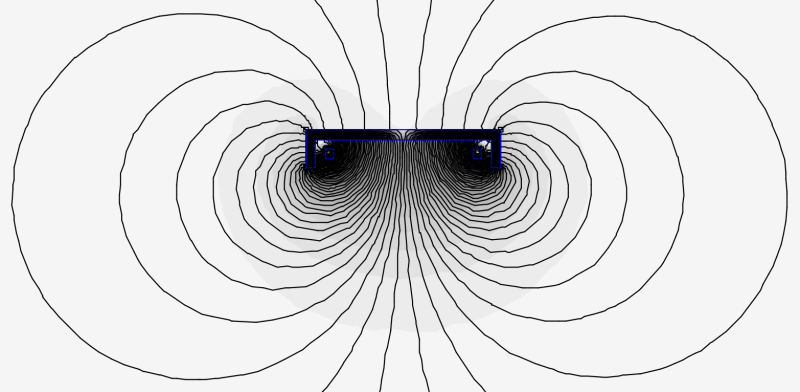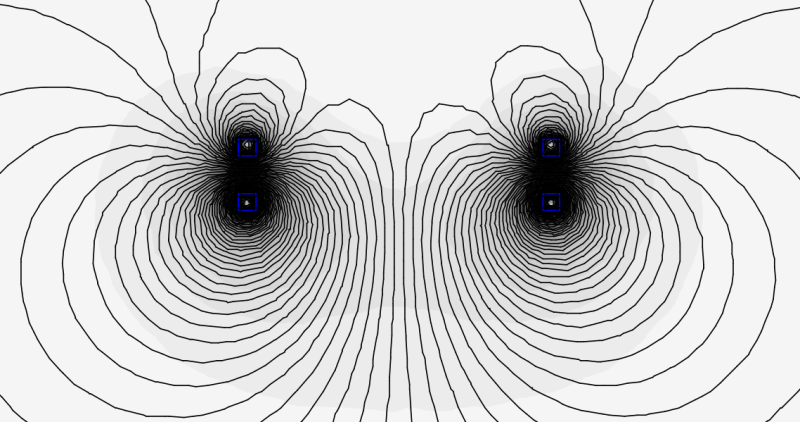-
Posts
581 -
Joined
-
Last visited
-
Days Won
5
Content Type
Forums
Detector Prospector Home
Detector Database
Downloads
Everything posted by Geotech
-

Stacked Spiral Coil Windings
Geotech replied to RONS DETECTORS MINELAB's topic in Detector Prospector Forum
So far, I've only done cross-sectional analyses of circular coils. I'm not sure it can do more complex shapes. It appears Elmer can, another free FEM tool, but I haven't found any idiot-training videos for Elmer as yet. I'm also to the point where I need to do some 3D analyses so if I find anything usable I'll post it here. -

Stacked Spiral Coil Windings
Geotech replied to RONS DETECTORS MINELAB's topic in Detector Prospector Forum
Jason: Yes, the anti-Helmholtz is a bit like a Halbach array. I once looked into a Halbach array for a medical detector. I don't know any way to trade off near-field for far-field, as far-field always follows near-field. "There is no free lunch." Chet: I'm using FEMM which is free and there are some Youtube instructional videos. After going through it a couple of times and setting up a few "starting point" coils, I can now do a sim in about 5 minutes. -

Stacked Spiral Coil Windings
Geotech replied to RONS DETECTORS MINELAB's topic in Detector Prospector Forum
Any time you place ferrite near a pancake coil it causes the flux lines to bend more. This is why mineralized ground reduces depth, it increases the flux curvature and reduces flux density at depth. Placing a ferrite shell on top of the coil certainly does what you envision (reduces the top-side field); at the same time it increases the bottom-side flux density very close to the coil but this advantage is quickly lost and at depth the flux density is reduced. Here is an FEM plot: Here is the same coil with the ferrite set to air: It's possible the ferrite-shelled coil would be good for shallow tiny nugget detection. Another (lighter) possibility is to design an anti-Helmholtz coil, where an anti-phased bucking coil placed just above the TX coil to "focus" the field downward: Unfortunately it tends to also reduce flux density at depth compared to just a single TX coil. . -

Stacked Spiral Coil Windings
Geotech replied to RONS DETECTORS MINELAB's topic in Detector Prospector Forum
A very interesting thread. Jason: No, adding ferrite won't help, it'll just make the coil heavy. The only exception is in a pinpointer where a ferrite rod is used to concentrate the field. This works well in a PI or energy theft pinpointer which use a mono coil. When you use an IB coil the RX must be air-cored so, ferinstance, the White's TRX has the TX coil wound on a ferrite rod but the RX coil is on a plastic bobbin. If this concept were used in a regular detector, you would have a big long ferrite for the TX coil with the RX underneath, so the coil is 8" thick and weighs 20 lbs. Chet: Have you ever tried using FEM software? -

First Texas Marketing
Geotech replied to phrunt's topic in First Texas - Bounty Hunter, Fisher & Teknetics
Is that a Garrett in the first pic? -

Legend Internals, Circuit Board, Processor, Etc.
Geotech replied to phrunt's topic in Nokta / Makro Legend Forum
It's a custom made display, you can only get it from Nokta. -
It's the same issue as described here. A shallow iron target will double-beep even with a brisk sweep but with deep iron the two beeps blend together (due to the geometry of depth vs coil size) unless you slow down the sweep rate. Deep non-ferrous can start to look ferrous because the ground response (with is almost purely positive-reactive) overwhelms the now-tiny negative-reactive portion of the non-ferrous, so that the target's reactive signal ends up looking ferrous. This is more likely to happen with low conductors than with Big Silver Coins. It also depends on the quality of the ground filters. Less likely to happen with the old 4-filter designs, which no one makes any more (AFAIK). Shallow non-ferrous can double-beep because as you get really close to the RX coil the edge of the coil becomes more sensitive than the center. Gold prospectors use this to "edge-detect" really small nuggets with PI mono loops.
-
I need to make some pattern measurements on a Cleansweep coil for my book. If anyone has one (either 4pin or 5pin, doesn't matter) and willing to loan it, I'll pay shipping both ways. I have a Cleansweep which has been sitting in a box for 10 years, I pulled it out and the null has shifted so badly it is unusable.
-
It's single frequency in that it only transmits a single frequency square wave. But that square wave has odd-order harmonics and the 3rd harmonic can be demodulated as a pseudo-second frequency and used for salt cancellation. Because the 3rd harmonic is much weaker, it does not make an effective second frequency for the purpose of detecting targets. That is, if you transmit a 5kHz square wave, the 15kHz 3rd harmonic is useful for salt cancellation but otherwise the detector performs mostly like a 5kHz single frequency. If this sounds familiar, it's exactly how the Fisher CZs did it back in 1991.
-
SMF is either 23 or 33 years old, depending on your definition of SMF. And I would not be so sure it's peaked.
-
That confirms what I've heard: high-end multifrequency with color display. From what I know they started work on this 12-13 years ago. It'll be interesting to see if they borrowed anything from the V3.
-
Apparently Republic is the gold capital of Washington State. 8 million ounces and still going. But few places for prospecting, it's all deep hard rock stuff. Almost ended up in White Salmon, gorgeous area.
-
Where abouts in Washington?
-
I posted a reply to Woody's video. The ferrites shield the solder connections so they don't light up with sudden changes in ground mineralization. Woody mentions this late in the video but doesn't seem to think that's what they're for.
-

Do Digital Detectors Lose Depth Over Time?
Geotech replied to Digalicious's topic in Metal Detector Advice & Comparisons
The core purposes of VFlex were (1) to transmit coil parametrics (like "this is a 10" DD coil optimized for 18kHz") to the control box and (2) to use a security check to limit 3d party coils. Whether or not #2 was an afterthought I don't know, but I suspect it was planned and deliberate, as it was for printer cartridges. A great way to limit competition. Otherwise, a simple resistor in the coil could be used to ID the coil type. The inclusion of a preamp in the coil might be considered part of VFlex, but in reality it has nothing to do with the micro that is the at core of VFlex. That is, you can do VFlex without the preamp in the coil, and you can put a preamp in the coil without the micro. But if there is no micro in the coil, then there is no VFlex. I don't recall that the original Go-Finds used VFlex, but the newer models apparently do. -
LMAO, I like that the coil appears to have a metallic housing. I would design it with vibranium, besides being durable it does not support eddy currents so is not detected.
-

Do Digital Detectors Lose Depth Over Time?
Geotech replied to Digalicious's topic in Metal Detector Advice & Comparisons
Placing the preamp in the coil improves noise immunity because the RX signal from the coil to the control box is now driven by a low impedance and has also been gained up. Minelab started this with the original X-Terras (30/50/70) and I assume all their detectors are now designed this way. I'm not sure if Garrett or Nokta do this, and XP obviously does. -
Looking for an 8x9 and 10x12 that will run on the 10/12 kHz models. Might also consider 17kHz coils.
-

Do Digital Detectors Lose Depth Over Time?
Geotech replied to Digalicious's topic in Metal Detector Advice & Comparisons
No, digital components don't change with age. The newer detectors still have 3 elements that can change, though: the coil, the preamp, and the ADC. The ADC and the opamp used in the preamp are pretty stable. The coil can shift over time, but that will mostly change the null and affects the point where it overloads, but depth should not vary. The preamp has resistors and capacitors, and that's mostly where depth variation can occur. Ironically, many newer designs place the preamp inside the coil so replacing the coil might be the solution if depth degrades. -

Indoor Viability For Metal Detectors??
Geotech replied to Dunnomuch's topic in Metal Detecting For Coins & Relics
Some fantastic caches have been found hidden in old homes, in walls and floors, attics, and buried in crawl spaces. Especially if it dates to the Great Depression. I know a guy who metal detected a burned-down house site, found gobs of silver coins and ingots that apparently had been in the walls. Another fellow I met had purchased an ex-grocery store building, found a big cache of silver dollars that were hidden by someone who worked there, went off to WWII and never came back. I would turn the sensitivity down to a minimum, even a small cache in the wall will sound big. A large coil will help minimize small targets like nails. Look for a strong localized target that seems out of place. -
I've never seen a screen cover "go bad." However, the display might. It's not clear when you say "the face don't light up very well" whether you mean the backlight isn't working well or the display itself is faded. But both can happen. Also, indoors it can be hard to read without the backlight. So first, I would take it outside or make sure the backlight is on. Next, I would pop off the pod faceplate (it snaps on) and look at the screen without the screen cover.
-
In a detector with only a single GB channel (like the TDI), it is possible to find a small range of conductivities at the conductivity transition point that are severely suppressed. When I air test the SDC with a continuous array of conductive targets, I can easily find the two transition points between the three regions. I could not find any range of suppressed targets with the SDC, target detection through both transition points was quite good. This tells me that the mathematical target holes are filled in. Again, that's in air. If particular targets are then lost in particular ground, then that could be due to the way the tracking algorithm is working, rather than the mathematical target hole. I suspect the same thing would happen in a multiperiod detector. In other words, you can eliminate the mathematical target hole with either multi-TX or multi-RX, but you will likely still face the same issues with certain targets in certain ground. I can see calling that a "target hole" but it may be a completely different issue.
-
Just saw this thread, and then read the older thread with Brent Weaver's video. I disagree with Brent (and so does Minelab, apparently) and posted a response in the older thread. In any case, once you have a "hole-less" detector, the channel responses can be used to extract a conductivity VDI, as the E1500 apparently does (I don't have one so I'm speculating). But this does not necessarily give ferrous discrimination as ferrous eddy responses can mimic nonferrous eddy responses. Steel bottle caps, ferinstance. But I'm keen to learn more about what the E1500 can do.




